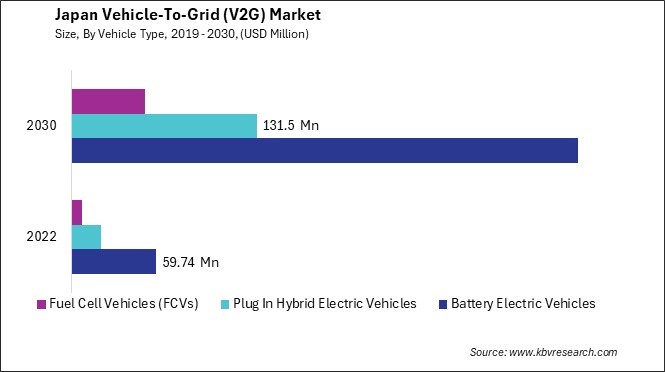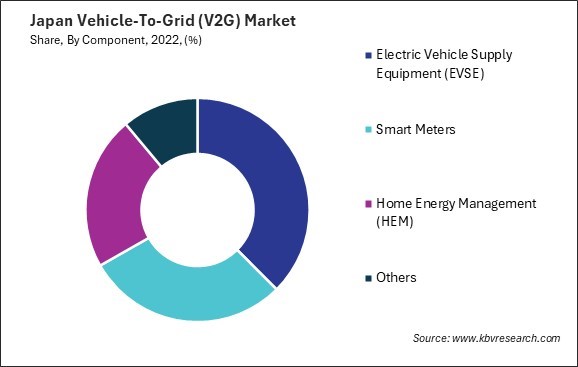Int'l : +1(646) 832-2886 | query@kbvresearch.com
Int'l : +1(646) 832-2886 | query@kbvresearch.com
Published Date : 17-May-2024 |
Pages: 78 |
Formats: PDF |
The Japan Vehicle-To-Grid (V2G) Market size is expected to reach $542.05 Million by 2030, rising at a market growth of 25.0% CAGR during the forecast period.
Japan's vehicle-to-grid (V2G) market is experiencing significant growth and evolving as a key component of the country's efforts to enhance energy efficiency, reduce greenhouse gas emissions, and promote sustainable transportation solutions. One of the driving factors behind the expansion of the vehicle-to-grid (V2G) market in Japan is the government's commitment to fostering a sustainable and resilient energy ecosystem. Japan has been a pioneer in adopting clean energy technologies, and V2G aligns with its goals of increasing renewable energy integration and minimizing the environmental impact of transportation.

In terms of infrastructure development, Japan has witnessed a steady increase in the deployment of V2G charging stations. These stations are strategically located in urban centers, commercial areas, and major transportation routes, facilitating convenient access for EV users. The expansion of charging infrastructure has played a pivotal role in addressing range anxiety among EV owners, further accelerating the adoption of V2G-enabled vehicles. The automotive industry in Japan has played a crucial role in the growth of the vehicle-to-grid (V2G) market. Leading automakers have been actively developing and promoting V2G-compatible electric vehicles. These vehicles are equipped with bidirectional charging technology, allowing them to charge their batteries and discharge electricity back to the grid when needed.
The COVID-19 pandemic has presented challenges and opportunities for Japan's vehicle-to-grid (V2G) market. The initial phase of the pandemic saw a temporary slowdown in the automotive and energy sectors, affecting production and deployment plans. Delays in infrastructure development and a shift in consumer priorities contributed to a brief setback in the momentum of the vehicle-to-grid (V2G) market. However, the pandemic highlighted the importance of resilient and sustainable energy solutions. These developments have positively impacted the vehicle-to-grid (V2G) market, paving the way for more efficient and responsive bidirectional energy flow between electric vehicles and the grid.
In recent years, Japan has witnessed a remarkable surge in adopting battery electric vehicles (BEVs), propelling the growth of the vehicle-to-grid (V2G) market. Japan's government has been at the forefront of promoting sustainable transportation, offering incentives and subsidies to encourage the purchase of electric vehicles. The introduction of generous subsidies for BEVs, coupled with tax breaks and exemptions from certain regulations, has significantly lowered the overall cost of ownership, making electric vehicles an attractive option for environmentally conscious consumers.
The Japanese automotive industry has played a pivotal role in this transition, with major manufacturers investing heavily in research and development of electric vehicle technology. Japanese automakers have introduced cutting-edge BEVs with extended ranges, quick-charging capabilities, and innovative features, further fueling consumer confidence in electric mobility.
According to the Japan Automobile Dealers Association (JADA), sales of new electric vehicles in 2020 reached close to 1.4 million. New electric vehicles accounted for 36.2% of total new car sales, up from 35.2% in 2019 and 32.9% in 2017. The robust demand for hybrid electric vehicles (HEVs) in Japan has been evident since the introduction of the Toyota Prius in 1997, with HEVs claiming a staggering 97.8% share of the new electric vehicles sold in 2020.
Other electric vehicle categories made smaller contributions, with plug-in hybrid electric vehicles (PHEVs) and battery electric vehicles (BEVs) each representing 1.1%, and fuel cell electric vehicles (FECVs) making up 0.1%. This signals a notable and increasing interest in the vehicle-to-grid (V2G) market, showcasing a gradual diversification in the preferences of Japanese consumers toward more sustainable and grid-integrated mobility solutions.
One distinctive feature driving Japan's vehicle-to-grid (V2G) market is the integration of smart grid technologies. Japanese utilities and technology companies have been working in tandem to develop sophisticated V2G systems, allowing electric vehicles to draw power from the grid and contribute excess energy back to it. Hence, Japan's surge in the adoption of battery electric vehicles, driven by government incentives and robust efforts from the automotive industry, has resulted in a significant industry shift towards sustainable mobility.
Japan has witnessed a significant surge in adopting vehicle-to-grid (V2G) technology, marking a substantial increase in power management capabilities within the automotive sector. One key driver of Japan's vehicle-to-grid (V2G) market is the government's strategic push towards a low-carbon future. Incentive programs and policies promoting electric mobility and smart grid integration have created a conducive environment for V2G development. The regulatory landscape has evolved to accommodate and encourage the integration of V2G systems, fostering collaboration between automotive manufacturers, energy utilities, and technology providers.
Japanese automakers have played a pivotal role in advancing V2G technologies. Collaborations between leading automotive companies and energy stakeholders have resulted in the development of V2G-ready vehicles and infrastructure. This synergy has increased the number of compatible vehicles on the road and expanded the reach of V2G-compatible charging stations in Japan.
Moreover, the growth of Japan's vehicle-to-grid (V2G) market is bolstered by the country's commitment to renewable energy sources. The integration of V2G aligns seamlessly with Japan's ambitions to increase the share of renewables in its energy mix. As solar and wind power capacity expands, V2G systems contribute to optimizing energy consumption and facilitating the efficient use of clean energy. Therefore, Japan's vehicle-to-grid (V2G) adoption surge is driven by government initiatives promoting a low-carbon future and a commitment to expanding renewable energy sources, aligning seamlessly with the nation's goal of optimizing energy consumption and promoting clean energy utilization.

Japan's vehicle-to-grid (V2G) market has been gaining significant traction in recent years, driven by the country's commitment to sustainable energy solutions and the growing importance of electric vehicles (EVs). One prominent player in the Japanese vehicle-to-grid (V2G) market is Nissan, a leading automobile manufacturer. Nissan has been at the forefront of EV innovation and has incorporated V2G capabilities in its electric vehicles, such as the Nissan LEAF. The company has been involved in pilot projects and collaborations with utility companies to test and implement V2G technologies. Nissan's commitment to sustainable mobility aligns with Japan's vision for a cleaner, more energy-efficient transportation system.
Panasonic is also making significant strides in the Japanese vehicle-to-grid (V2G) market. The company, known for its electronics and automotive technologies, is actively developing V2G solutions to facilitate the seamless integration of EVs into the grid. Panasonic's efforts focus on creating intelligent energy management systems that optimize the use of renewable energy and enable efficient energy transfer between vehicles and the grid.
Another key player is TEPCO (Tokyo Electric Power Company Holdings), one of the largest utility companies in Japan. TEPCO has been investing in V2G infrastructure and smart grid technologies to enhance the integration of renewable energy sources and manage the increased demand for EVs. The company aims to create a robust V2G network that enables bidirectional energy flow between electric vehicles and the grid, contributing to grid stability and reducing the transportation sector's carbon footprint.
In addition to these major players, several startups have emerged to address specific niches within the vehicle-to-grid (V2G) market. Ecosystem Japan, for example, specializes in providing V2G software solutions that enable communication between electric vehicles and the grid. The company's platform aims to streamline energy flow management, allowing for real-time monitoring and control. As the adoption of electric vehicles continues to rise, the vehicle-to-grid (V2G) market is poised to play a crucial role in enhancing grid resilience, optimizing energy use, and contributing to a more sustainable and eco-friendly transportation ecosystem in Japan.
By Technology
By Vehicle Type
By Charging Type
By Component